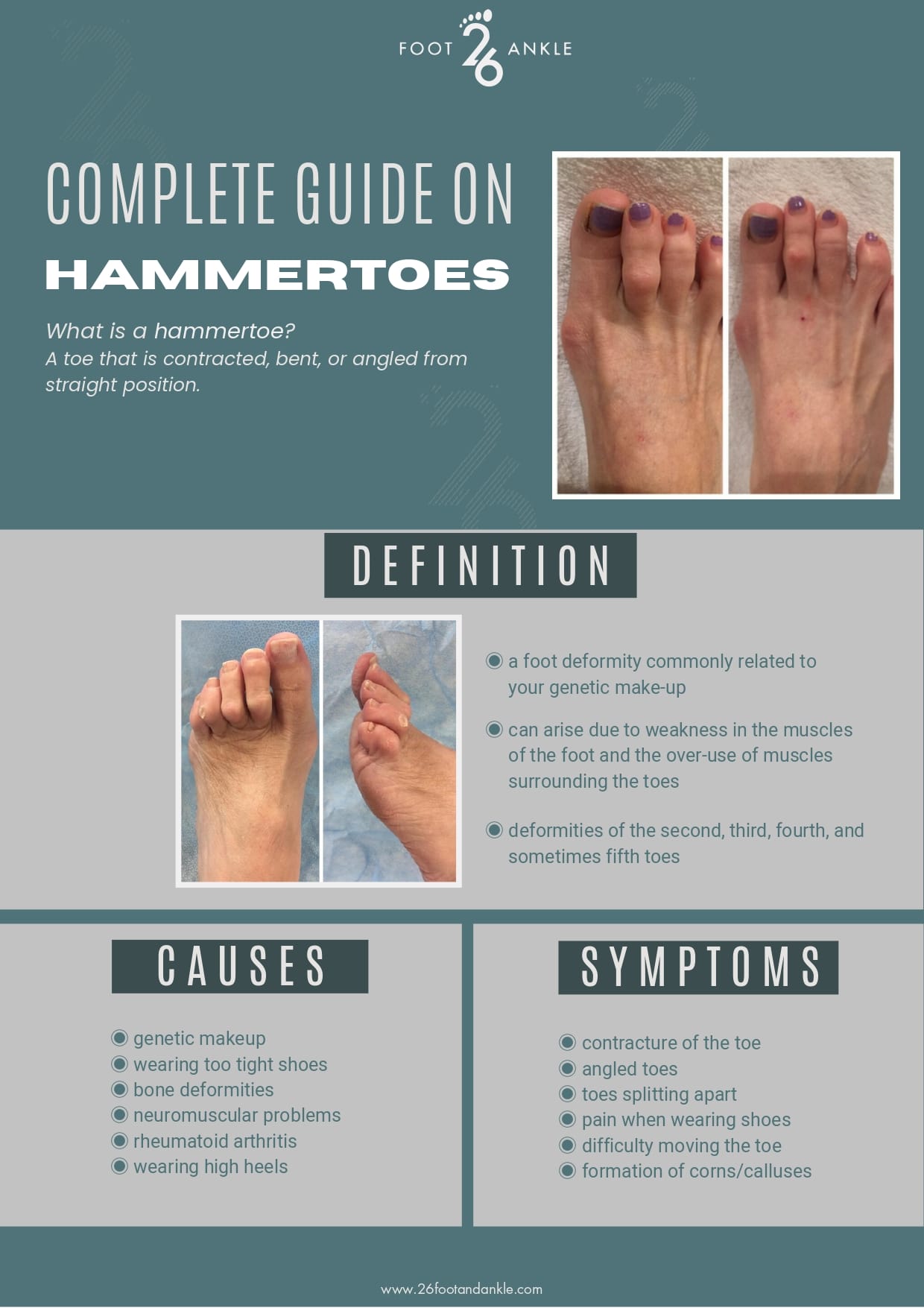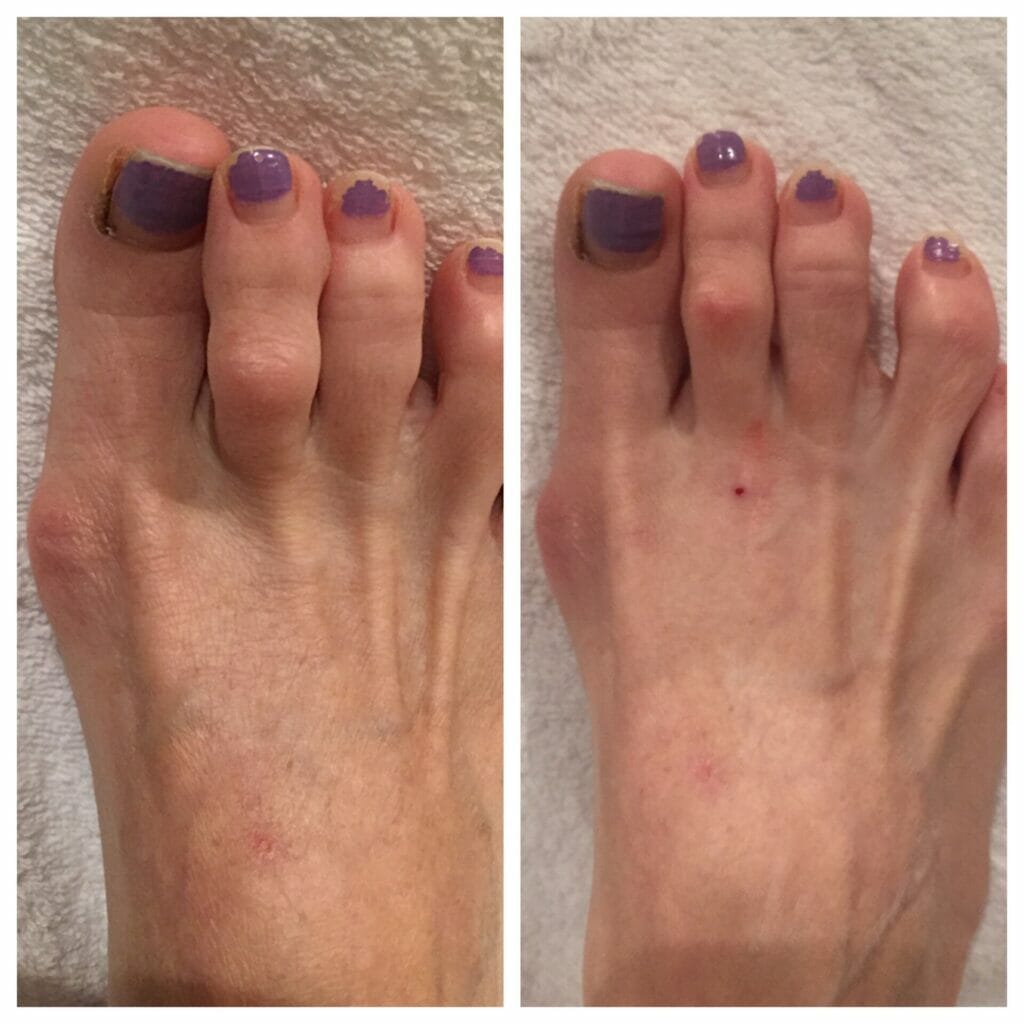The 26 Review
- What is Hammertoe? A toe that is contracted, bent, or angled from straight position
- Causes Genetics, wearing shoes that are too tight or too narrow
- Symptoms Swelling, blisters, skin discoloration, and corn(s) on the top of the toe(s)
- Diagnosis Physician experience, physical examination, X-ray
- Treatment Gel pads and splints, shoe modifications, orthotics, in-office procedure, surgery
Hammertoes: Mild E-Book


HAMMERTOES
Transform your toes, transform your life! Our latest ebook is your essential guide to conquering hammertoes and stepping into a world of comfort and confidence. Explore practical tips and expert insights to relieve discomfort and prevent future issues. Ready to reclaim happy, healthy feet? Download now and take the first step towards comfort and confidence!

Let’s take a closer look…
Hammer toes are deformities of the second, third, fourth, and sometimes fifth toes. Hammertoes are initially flexible and can be corrected with simple non-surgical measures, but, if left untreated, they are likely to become fixed and require either an in-office procedure or surgery.
Hammertoes oftentimes can be classified as being classic, or hammertoe, mallet toe, or claw toe. Hammertoes are a foot deformity commonly related to your genetic make-up. They can arise due to weakness in the muscles of the foot and the over-use of muscles surrounding the toes. In some cases, abnormal lower limb foot and ankle deformities change an individual’s gait and can lead to deformities in the rest of the foot, including hammertoe contractures. A first step in management should be the implementation of conservative measures such as mild hammertoes may be alleviated with various treatments including wide-toed shoes, toe pads, and orthotics. If conservative management fails and pain persists, surgical intervention may be needed. Depending on the characteristics of the hammertoe(s) deformity, the surgical approach differs. In order to meet the patient’s needs, proper clinical evaluation is vital.
Causes
In a majority of cases, hammertoes are a result of one’s genetic make-up. Hammertoes are commonly associated with one’s foot type and foot structure, with some individuals unfortunately being predisposed to developing hammertoe contractures at an early age. The most common non-genetic cause of hammertoe is wearing shoes that are too tight. This puts pressure on the toe and forces it to bend. Other causes include bone deformities, neuromuscular problems, and rheumatoid arthritis. Wearing high heels can also contribute to the development of hammertoe(s). It’s important to take your time in choosing your footwear so you don’t put yourself at unnecessary risk for developing this condition.
Symptoms
If you have a hammertoe, you may be experiencing one or more of the following symptoms: Contracture of the toe, angled toes, toes splitting apart, pain in or top of the toe(s) when wearing shoes, difficulty moving the toe, thickening of the skin on the toe, and/or formation of corns or calluses. If not treated, hammertoes can become increasingly stiff / inflexible and painful. In severe cases, the toenail(s) can also become deformed.
Diagnosis
Most often, hammertoes are diagnosed during a routine physical exam by your doctor or Podiatrist. He or she will ask you about your symptoms and perform a thorough examination of your feet. This examination will likely include an evaluation of your shoes and an assessment of any redness, swelling, corns, calluses, or toenail problems you may have. Your podiatrist will typically order X-rays to further evaluate the bones and joints of your toes. Imaging will help your physician determine the degree of your deformity and whether or not surgical measures need to be discussed.
Treatment: Non-surgical For Hammertoes: Mild
In earlier stages, hammertoes are flexible and the symptoms can often be managed with noninvasive measures; treatment is typically directed towards pain relief by accommodations made around painful corns and calluses. Gel pads and shoe modifications are simple measures that can offer significant pain relief. Prescription strength creams can also be effective in treating the increased skin buildup. Re evaluating your current shoe choices may be difficult but many times necessary when it comes to naturally relieving the pain associated with hammertoe deformities. Examining your most worn shoes and taking the time to remove any shoes that are too narrow or too tight will greatly improve your chance of alleviating some of your hammertoe symptoms naturally. Various types of painkillers, such as ibuprofen, may be recommended to alleviate pain and reduce inflammation. In mild hammertoes and particularly those that have not become stiff and rigid, an in-office procedure is an option for some individuals. If applicable, this allows for a more effective treatment option with the benefit of avoiding the intricacies of a full surgery, including patient safety, downtime and money.
Treatment: Surgical For Hammertoes: Mild
As hammertoes become more rigid and the conservative options described above prove unhelpful, hammertoe surgery is very effective in correcting the underlying problems associated with the contracted joints. Typically, the small joints of the toe(s) are fused into a corrected position, while contractures within the associated tendons are released. These procedures are effective at providing a long-lasting solution for individuals. Your foot and ankle surgeon will take into account the extent of the deformity, the number of involved toes, your age, and your level of activity, among other factors, when choosing whether to perform one procedure or a combination of procedures. Our physicians are board certified in foot and ankle surgery and routinely perform hammertoe surgery. If conservative measures have failed to give your toes pain relief, our physicians are available to discuss your surgical options.